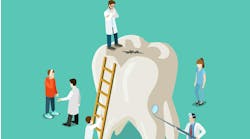By David Gane, DDS
The discussion is growing on the effectiveness and importance of oral cancer screening as further research emerges. Recently Dr. David Gane, CEO of LED Medical Diagnostics Inc., sat down with Dr. Ed Truelove, professor and clinical service chief of the Department of Oral Medicine, University of Washington, who offered some key insights into this ongoing discussion.
Dr. Ed Truelove: It is important to first clarify that oral cancer screening should be inclusive of more than just the mouth. Completion of a soft- and hard-tissue examination of the head, neck, and oral cavity should be part of all dental assessments because there are many conditions that can be present, and many of them have potentially significant effects on the health and quality of a patient's life when undetected or untreated. Oral premalignant and malignant lesions are two of the most important of these conditions. To suggest that including observation and evaluation for detection of oral cancer or premalignant changes is a waste of time when an exam is already being done seems bizarre, since the additional time required is minimal and the value of positive findings is so significant. Imagine an oral cancer patient returning to their dentist and asking them if they had seen any signs of malignant or premalignant changes, and the dentist responding, "I didn't look and I didn't know that you wanted me to look since the risk is so low."
Gane:When it comes to performing a clinical oral examination, there are several aspects to consider. What does a comprehensive exam look like, and how long should it take?
Truelove: A comprehensive exam is not a complex process. An exam consists of a visual inspection of the head, neck, and oral and oropharyngeal tissues in conjunction with palpation of those tissues. Adjunctive aids may assist in the detection of changes not as obvious otherwise. Adjunctive tools can include magnification, improved and special lighting, photography and video, along with more advanced diagnostic aids that use fluorescence visualization. The whole examination normally takes less than five minutes when done by an experienced dentist or health professional. We and others have investigated the value of adding fluorescence visualization to the routine oral exam and found a significant number of tissue changes not visible with normal light; a number of those changes represented dysplastic lesions with potential for further premalignant progression.
Gane: HPV is observed to increase the incidence of oral cancer, particularly in younger demographic groups. How does this change the dental professional's approach to oral cancer screening, and what advice can you share on confronting this demographic change?
Truelove: HPV has changed our focus to some degree since it appears that the virus does increase the risk for some types of cancers on the base of the tongue, tonsils, and pharyngeal tissues. Recent research estimates that approximately 6% of oral cavity cancers and approximately 70% of oropharyngeal cancers are HPV-related. The oropharynx and base of the tongue can be hard to visualize, and intraoral visual signs can be extremely subtle or nonexistent, even after the cancer has spread to lymph nodes. This highlights the importance of conducting a proper examination both intraorally and extraorally.
Gane:Oral mucosal abnormalities can be a difficult topic to discuss with patients. What advice would you give clinicians and hygienists to help them tackle the topic of oral cancer while performing a clinical oral examination?
Truelove: I suggest that clinicians not shy away from discussing this issue during the process of evaluation of the patient. Ask questions and let patients know about signs and symptoms suggestive of cancer, and lifestyle issues that are associated with increased risk.
Gane:How do you see the role of the general dentist changing in the future in relation to the practice of oral medicine?
Truelove: Most experts agree that the role of oral medicine in the dental practice will continue to expand. With longer life expectancies and more people living with chronic diseases, the opportunity for the dental profession to participate in the management of patients' overall health is increasing.
Gane:In your opinion, how can dentists build stronger and more effective partnerships with medical doctors and specialists?
Truelove: They can do so through direct discussion with their physician colleagues when they have findings of potential medical importance, and by communicating with them when they have medical history, general symptoms, or examination findings of potential significance.
Ed Truelove, DDS, MSD, is professor and clinical service chief of the Department of Oral Medicine, University of Washington. He is past president of the American Board of Oral Medicine, and currently chair of the Council on Scientific Affairs of the American Dental Association, of which he is a longstanding member.
Past DE Issues







